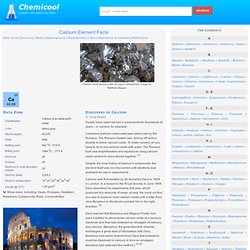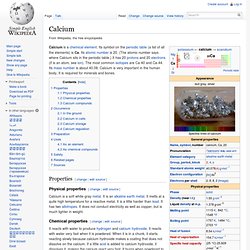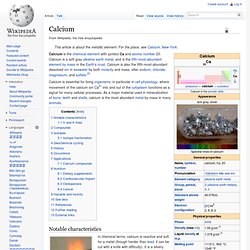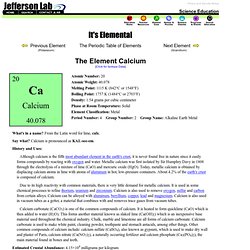

Project: Calcium- It's Elemental by Taylor P on Prezi. Calcium. Calcium metal stored under an argon atmosphere.

Image by Matthias Zepper. Data Zone Show more, including: Heats, Energies, Oxidation, Reactions, Compounds, Radii, Conductivities Rome’s Colosseum, resisting the ravages of time (okay, there are one or two missing pieces…) with the aid of calcium oxide based cement. Photo: David Iliff, Creative Commons Licence. Stalactites – Mainly Calcium Carbonate. Discovery of Calcium Dr. People have used calcium’s compounds for thousands of years – in cement, for example. Limestone [calcium carbonate] was called calx by the Romans.
Despite the long history of calcium’s compounds, the element itself was not discovered until electricity was available for use in experiments. Calcium was first isolated by Sir Humphry Davy in 1808 in London. Davy learned that Berzelius and Magnus Pontin had used a battery to decompose calcium oxide at a mercury electrode and they had obtained an amalgam of mercury and calcium. Calcium - The Element in Action. Calcium: Say It. Calcium Facts - Periodic Table of the Elements Facts about Calcium. Calcium Calcium Basic Facts: Symbol: CaAtomic Number: 20Atomic Weight: 40.078Classification: Alkaline EarthCAS Number: 7440-701-2 Calcium Periodic Table Location Group: 2Period: 4Block: s Calcium Electron Configuration Short Form: [Ar]4s2Long Form: 1s22s22p63s23p64s2Shell Structure: 2 8 8 2 Calcium Discovery Discovery Date: 1808Discoverer: Sir Humphrey Davy [England]Name: Calcium derives its name from the Latin 'calcis' which was the word for lime (calcium oxide, CaO) and limestone (calcium carbonate, CaCO3)History: The Romans prepared lime in the first century, but the metal was not discovered until 1808.

Calcium Physical Data State at room temperature (300 K): SolidAppearance: fairly hard, silvery white metalDensity: 1.55 g/ccSpecific Gravity: 1.55 (20 °C) Melting Point: 1115 KBoiling Point: 1757 KCritical Point: 2880 K Heat of Fusion: 8.54 kJ/molHeat of Vaporization: 154.7 kJ/molMolar Heat Capacity: 25.929 J/mol·KSpecific Heat: 0.647 J/g·K (at 20 °C) Calcium. Very pure calcium metal, not corroded Calcium metal in air, corroded Calcium is a chemical element.

Its symbol on the periodic table (a list of all the elements) is Ca. Its atomic number is 20. (The atomic number says where Calcium sits in the periodic table.) Properties[change | edit source] Physical properties[change | edit source] Calcium - Periodic Table of Videos. Calcium. Notable characteristics Flame test.

Brick-red color originates from calcium. Calcium, with a density of 1.55 g/cm3, is the lightest of the alkaline earth metals; magnesium (specific gravity 1.74) and beryllium (1.84) are more dense, although lighter in atomic mass. From strontium onward, the alkali earth metals become more dense with increasing atomic mass. It has two allotropes.[5] Calcium has a higher electrical resistivity than copper or aluminium, yet weight-for-weight, due to its much lower density, it is a rather better conductor than either. Calcium salts are colorless from any contribution of the calcium, and ionic solutions of calcium (Ca2+) are colorless as well.
Calcium is the fifth-most-abundant element by mass in the human body, where it is a common cellular ionic messenger with many functions, and serves also as a structural element in bone. H and K lines Visible spectra of many stars, including the Sun, exhibit strong absorption lines of singly ionized calcium. Compounds. The Element Calcium.
[Click for Isotope Data] Atomic Number: 20 Atomic Weight: 40.078 Melting Point: 1115 K (842°C or 1548°F) Boiling Point: 1757 K (1484°C or 2703°F) Density: 1.54 grams per cubic centimeter Phase at Room Temperature: Solid Element Classification: Metal Period Number: 4 Group Number: 2 Group Name: Alkaline Earth Metal What's in a name?

Say what? History and Uses: Although calcium is the fifth most abundant element in the earth's crust, it is never found free in nature since it easily forms compounds by reacting with oxygen and water. Due to its high reactivity with common materials, there is very little demand for metallic calcium.